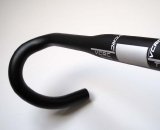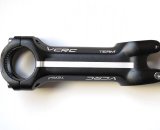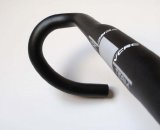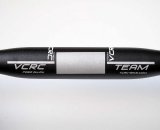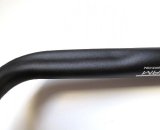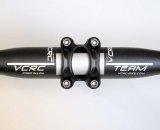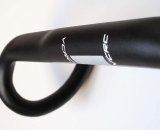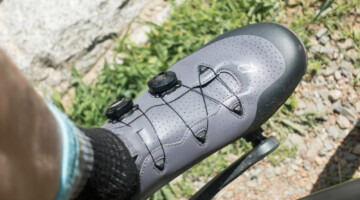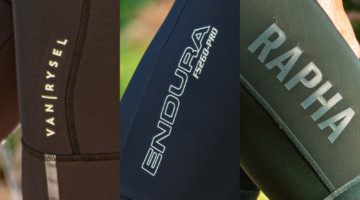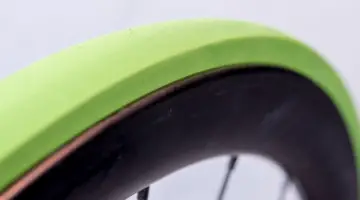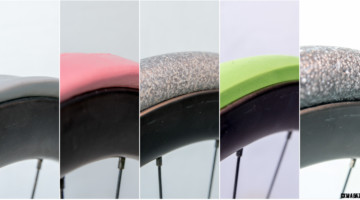by Clifford Lee
2011 VCRC Team handlebar and stem
MSRP $79 (bar) $59 (stem)
Alloy handlebar and stems are usually not glamorous. Once set up, they simply perform as they should in most cases, and we tend to take them for granted. There is personal preference regarding reach of the stem and bar as well as the depth and curve of the bar’s drop, but they’re not sexy like the multi-shaped carbon variations popular on the road. But they tend to be reliable, functional and forgiving of accidents. Thus I tend to prefer alloy handlebars and stems over carbon on my bikes.
VCRC is a performance upgrade company, focused on ceramic bearing upgrades. The one area where the company strays from that specialty is with its bar, stem and seatpost offerings. The company saw an opportunity to offer improvement over existing products. The Team bar and stem was developed with the input of customers and sponsored racers to offer better stiffness for control and power transfer, and better usable grip positions. The bend of the 7050 alloy matte black bar is shallow and round, with a 125 mm drop and a short 70 mm reach. There’s a flat section along the bar top, with a groove under this flat section for cable routing. The 6061 alloy stem has a thick octagonal cross-section with a four-bolt faceplate and opposing steerer clamp bolts.
This is a stout set up with a stem weight of 172 grams for an 11cm stem, and 289 grams for a 44cm (measured center to center) bar. These aren’t featherweights, but are likely lighter than common OEM components on entry or mid-level cyclocross bikes. They’re not designed specifically for cyclocross, but said to be well suited for the rigors of ’cross. Each component is very stiff, more than any bar and stem combo I’ve used in the recent past. I pushed and yanked on this setup and it didn’t yield. This would be great for a power sprinter or a Clydesdale rider.
I like the shallow drop — it allows me to ride in the drops more, allowing better power, aerodynamics, braking and control. The short reach brings the brake hoods closer when I want to ride on the hoods and the flat top section is nice when you need to power through the bumps or if you’re so far ahead you can sit up and cruise. The flat section does limit the position of bar top levers if you chose to use them, they can only be mounted on the 31.8 round section near the stem. A common trait with compact bend bars is the that the bar ends protrude further back, but that’s less true on the VCRC Team. I didn’t bang my knees (or any other body part, for that matter) on the ends of the drops.
Both the stem and the handlebar have a relatively small selection of size options, but they’re common and versatile ones. The stem comes in a +/- 6 degree rise and a 41mm stack height with just three lengths: 100, 110 and 120mm. The rise and stack height allows a decent range of adjustability in terms of handlebar height. Point it up or down, throw some spacers on top or below, and you’ve got a decent range of adjustment unless you have back issues or have an extreme position and tall head tube. For the bars, you’ve got just 42cm and 44cm options, so smaller or really large-framed folks will have to look elsewhere.
My concerns that the bar and stem’s stiffness would compromise comfort or control were not supported. The subjective feeling of comfort is multifaceted, and the role of the bar and stem is pretty minor compared to tire inflation, frame and fork. Even bar tape impacts comfort far more than a handlebar’s stiffness. That being said, keeping all things equal, the vibration and jarring felt at the bar is slightly increased compared to my lightweight alloy setup when using this bar and stem combination. But there’s a good upside — I also noticed the VCRC’s stiffness when pulling up on the bar while sprinting and climbing. And although stiffness and durability are not always correlated, it’s very nice knowing that the extra material in the VCRC Team components’ design should offer better durability and more protection from the inevitable spills I’ll take.
Conclusion:
I like the bar and stem’s stiffness, the short, shallow bend and even the comfortable flat section on top. They seem to be well-suited for the abuse of cyclocross, and are confidence-inspiring even if you can’t always keep you and your bike upright.
I’m neither a powerful sprinter nor a heavy rider (155 pound masters racer), and so the added stiffness and expected durability may not trump the weight penalty for me — I might opt for something like the lighter VCRC Pro series components for my race bike. But if you’re a bigger guy, a more powerful rider or are looking for something you set up once and hope to forget for many years, the VCRC Team stem and handlebar are definitely worth a look.
Note: VCRC seems to run sales quite often, and these components as of the date of this review are currently on sale. Also, I just noticed VCRC recently inked a deal with USA Cycling, allowing licensed members to get a discount on its products, and that could be a way of putting your license to work to save you some cash while upgrading your bike.
Product Details:
VCRC Team handlebar:
MSRP $79 (currently on sale for $59)
Weight: 289 grams (44cm c-c bar)
Materials: 7075 aluminum
Sizes available: 42 and 44cm, 125mm drop
VCRC Team stem:
MSRP: $59 (currently on sale for $49)
Weight: 172 grams (110 mm)
Materials: 6061 aluminum
Sizes available: 100, 110, and 120mm
Clamp: 31.8 (oversize) clamp – 1 1/8 steerer clamp
Rise: +/- 6 degree rise
Stack height: 41mm
For more info: http://vcrcbike.com
Photo Gallery:













